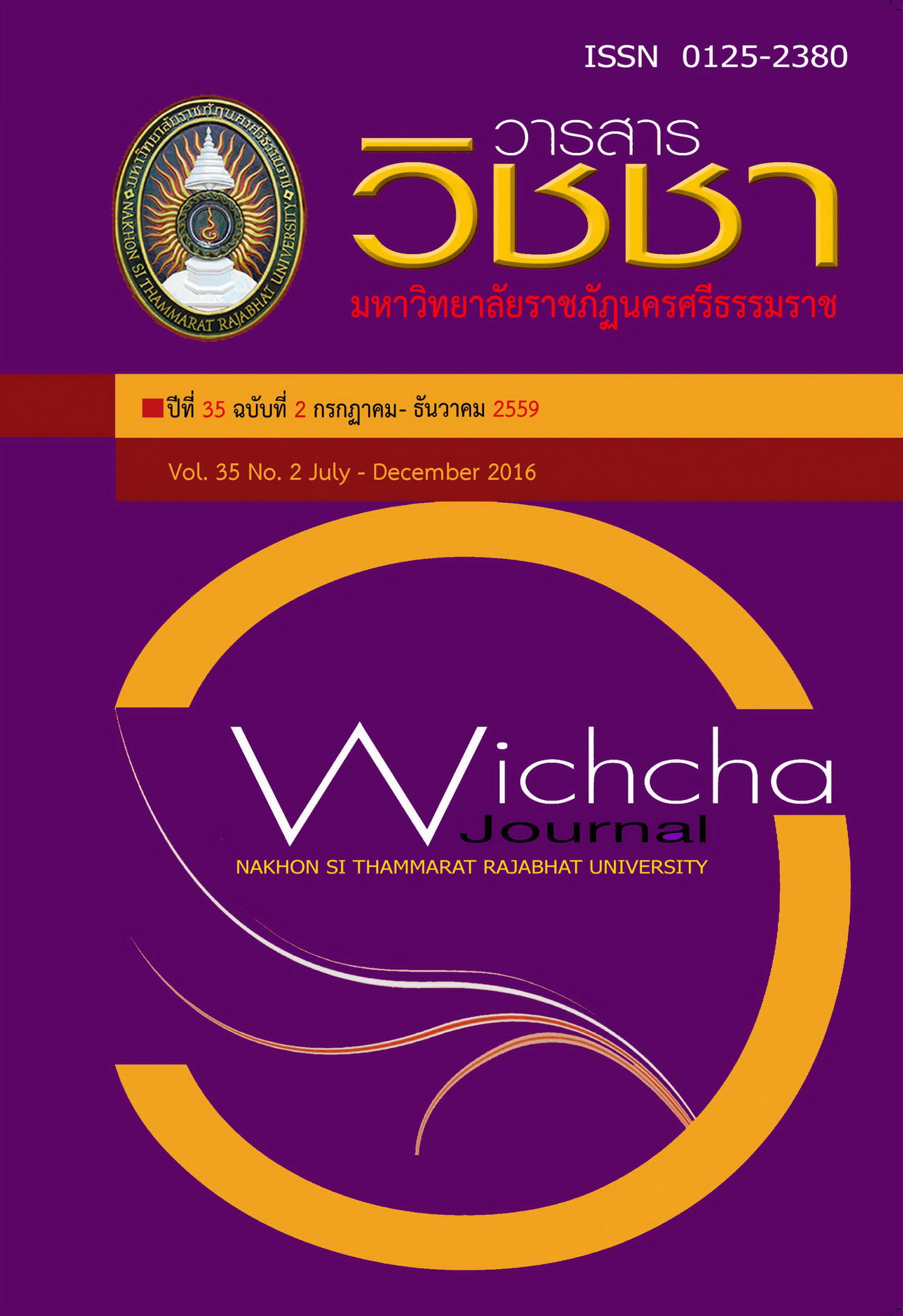การพัฒนาสีเขียนบนเครื่องปั้นดินเผาจากดินและตับหินสีธรรมชาติ Development of Color Pigment Painting on Pottery from Natural Clay and Stone Colors
Main Article Content
Abstract
งานวิจัยนี้มีวัตถุประสงค์เพื่อพัฒนาสีสำหรับเขียนบนเครื่องปั้นดินเผาพื้นบ้านจากดินและตับหินสีท้องถิ่นตามธรรมชาติ สำหรับกลุ่มสินค้าตกแต่งอาคารและสวนกลางแจ้งจากวัตถุดิบท้องถิ่นจังหวัดนครศรีธรรมราชโดยทำการศึกษากับดินและตับหินสีจำนวน 5 ตัวอย่าง จากตับหินเขามหาชัย,ดินลูกรังเขามหาชัย, ตับหินเหลืองบ้านวัดโหนด, ดินดำลานสกา และดินเลนนากุ้งในถุ้งด้วยการใช้อัตราส่วนผสมแบบตารางสามเหลี่ยมด้านเท่า (Tri-axial diagram) ร่วมกับวัตถุดิบเพิ่มความเข้มของสี(Intensity pigment) ได้แก่ สนิมเหล็ก และสารช่วยยึดเกาะ (Binder) ได้แก่ น้ำยางกล้วย
ผลการศึกษาพบว่า อัตราส่วนระหว่าง ดินและตับหินสี : สนิมเหล็ก : น้ำยางกล้วยที่นำมาใช้เป็นวัตถุดิบในการทดลองสามารถพัฒนาสีเขียนบนเครื่องปั้นดินเผาพื้นบ้านได้ 5 เฉดสี ได้แก่1) สีเหลืองอ่อนจากตับหินเขามหาชัย มีอัตราส่วนเท่ากับ 82 : 8 : 10, 2) สีน้ำตาลแดงจากดินลูกรังเขามหาชัยมีอัตราส่วนเท่ากับ 80 : 10 : 10, 3) สีเหลืองส้มจากตับหินเหลืองบ้านวัดโหนด มีอัตราส่วนเท่ากับ 75 : 15 : 10, 4) สีขาวครีมจากดินดำลานสกา มีอัตราส่วนเท่ากับ 90 : 0 : 10, และ 5) สีเขียวขี้ม้าจากดินเลนนากุ้งในถุ้งมีอัตราส่วนเท่ากับ 69 : 21 : 10 โดยสีเขียนทั้ง 5 เฉดสีสามารถให้สีที่สม่ำเสมอได้ที่อุณหภูมิระหว่าง 750-1,050 องศาเซลเซียส ไม่หลุดร่อนจากผิวเครื่องปั้นดินเผา ทนต่อการใช้งานและเหมาะสมต่อการเขียนสีด้วยพู่กัน ผลการสอบถามความพึงพอใจต่อการนำไปทดลองใช้กับผู้ผลิตระดับชุมชนเกี่ยวกับการเขียนสีมีความพึงพอใจเฉลี่ยอยู่ในระดับมาก (X???? = 4.41, S.D. = 0.58)
This research aimed to develop the pigment for decoration on folk potteryfrom natural clay and stone colors, for indoor and outdoor gardens, from Nakhon SiThammarat material. The study were 5 samples from weathered rock of the MahaChaimountain, red clay of the Maha Chai mountain, the yellow weathered rock of the WatNode,the ball clay of Lan Saka, and the mud shrimp clay of Nai Tong; Using the Triaxialdiagram with mixing Intensity pigment from rust and binder from banana latex.
The results showed that the ratio of clay and rock colors: rust: Banana latexused as raw materials in the experiment could be developed 5 color shades on folkpottery: 1) light yellow from weathered rocks of the Maha Chai mountain at 82: 8:10,2) red-brown from red clay of the Maha Chai mountain at 80: 10: 10, 3) yelloworangefrom yellow the weathered rock of Wat Node at 75: 15: 10, 4) white-creamfrom the ball clay of Lan Saka at 90: 0: 10, and 5) peacock green from the mudshrimp clay of Nai Tong at 69: 21: 10. Using of 5 color shades could provide consistent at temperatures between 750-1,050 °C, non-peeling out of pottery skin, resistant applications and suitable for painting with a brush. The satisfaction of community manufacturers about the painting were at good level (X???? = 4.41, S.D. =0.58).
Article Details
เนื้อหาและข้อมูลในบทความที่ลงตีพิมพ์ในวารสารวิชชา มหาวิทยาลัยราชภัฏนครศรีธรรมราช ถือเป็นข้อคิดเห็นและความรับผิดชอบของผู้เขียนบทความโดยตรง ซึ่งกองบรรณาธิการวารสารไม่จำเป็นต้องเห็นด้วยหรือร่วมรับผิดชอบใด ๆ
บทความ ข้อมูล เนื้อหา รูปภาพ ฯลฯ ที่ได้รับการตีพิมพ์ในวารสารวิชชา มหาวิทยาลัยราชภัฏนครศรีธรรมราช ถือเป็นลิขสิทธ์ของวารสารวิชชา มหาวิทยาลัยราชภัฏนครศรีธรรมราช หากบุคคลหรือหน่วยงานใดต้องการนำข้อมูลทั้งหมดหรือส่วนหนึ่งส่วนใดไปเผยแพร่ต่อหรือเพื่อการกระทำการใด ๆ จะต้องได้รับอนุญาตเป็นลายลักษณ์อักษรจากวารสารวิชชา มหาวิทยาลัยราชภัฏนครศรีธรรมราชก่อนเท่านั้น
The content and information in the article published in Wichcha journal Nakhon Si Thammarat Rajabhat University, It is the opinion and responsibility of the author of the article. The editorial journals do not need to agree. Or share any responsibility.

